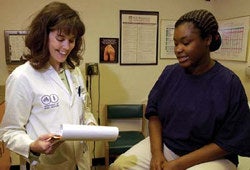ECU aims for speedier scheduling
A new plan will allow patients to make an appointment and be seen that same day

Dr. Janalynn Beste talks with a patient.
GREENVILLE, N.C. (May 4, 2001) — Imagine this: A patient who’s put off his annual physical exam finally calls his doctor’s office for an appointment. The receptionist tells him he can come in at 1 p.m. or 3:30 p.m. that day. That’s not just wishful thinking. It’s the future, and it’s coming to the Family Practice Center of the Brody School of Medicine at East Carolina University beginning this summer.
The plan will start with the Orange Module then move into the other three modules of the practice. Same-day scheduling, also called ‘open access,’ makes good sense for primary care. It’s the direction that primary care needs to move toward in the new millennium, said Dr. Mark Darrow, associate professor of family medicine and director of clinical services. We have had a lot of advances in medicine but we’re still using the same appointment system developed during the 18th century, said Darrow, who is also associate medical director of ECU Physicians. In a shift migrating across the country, physicians’ offices are moving from booking patient appointments weeks and sometimes months in advance to open-access scheduling. Currently, appointments at the Family Practice Center are scheduled anywhere from a few days to a month in advance. If your car breaks down this morning, you want a mechanic to see it today. We don’t have the same expectations for medicine, and we should, Darrow said. Kaiser Permanente pioneered same-day scheduling a few years ago in northern California, according to an article in the Jan. 29 issue of American Medical News. Dr. Mark Murray, who formerly headed the Kaiser Permanente Sacramento Medical Center’s family practice department, developed it. As Kaiser analyzed operating procedures in the mid-1990s, the company found patients hated having to schedule appointments months in advance. Several things were tried to ease the waiting time” adding more physicians, centralizing appointment scheduling” but nothing helped. We were roughly matching supply and demand. But we were two months late, Murray said in the American Medical News article.
The solution he came up with was to drop advance scheduling, stop differentiating between urgent and non-urgent visits and do today’s work today. Darrow said that same-day scheduling makes sense in today’s fast-paced world. It fits well into people’s busy schedules, and those busy schedules are what cause many of our no-shows. It forces us to use the appointment system inefficiently, he said. Darrow was hesitant to peg the number of no-shows for appointments each week at the Family Practice Center but did say it was high. The Orange Module of the Family Practice Center, like the other three modules in the center, sees about 750 to 900 patients each month. Ten resident physicians, four attending physicians and two physician extenders are based on the unit. Dr. Janalynn Beste, assistant professor of family medicine and leader of the Orange Module, has been discussing same-day scheduling with Darrow for more than a year. I’ve spoken with other physicians who have open access in their practices, from a private practice physician in Wisconsin to a physician in an academic medicine setting in Tennessee she said. They all are positive about the change. I really think that patients will like same-day scheduling. We hope that it will mean patients will be seen when they want to be seen, [and] not have to wait weeks or even a month. It has taken a team approach to prepare for this change, said Dr. Dean Patton, chairman of the Department of Family Medicine at the medical school. This group has really committed themselves to making sure needs of patients are met. Patton added, There is an increasing awareness that we need to measure success on how well we serve patients. There are several problems with the current system that make keeping service at the forefront of our thinking vital.